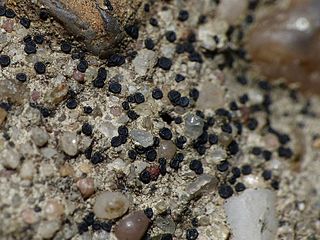Teuvo ("Ted") Tapio Ahti is a Finnish botanist and lichenologist who has made significant contributions to the taxonomy and biogeography of lichens. Known particularly for his work on the lichen family Cladoniaceae, he has had a long career at the University of Helsinki beginning in 1963, and following his retirement in 1997, has continued his research at the Botanical Museum of the Finnish Museum of Natural History. His research output spans more than seven decades, comprising over 450 scientific publications across lichenology, mycology, and botanical science.
Orvo Vitikainen is a Finnish lichenologist. He entered the University of Helsinki in 1961, from where he obtained a Candidate of Philosophy degree in 1966, and a Licentiate of Philosophy in 1971. He later earned a Ph.D. from this institution in 1994, under the supervision of Teuvo Ahti. Between the years 1961 and 1981 he was a junior curator of cryptogams at the University of Helsinki Botanical Garden, and then from 1983 to 2004 he was the head of the lichen herbarium. Here he managed the internationally valuable collections of the early lichenologists Erik Acharius and William Nylander. He has collected thousands of specimens for the herbarium from various locations in Finland, but also internationally, including Sweden, Norway, Denmark, Russian Karelia, Scotland, Austria, Italy, Hungary, Croatia, Montenegro, Tanzania, Kenya, British Columbia, and Brazil. In 1992–1994, he was a scientist of the Finnish Academy in the Ahti research group.
Rainar Alarik Hakulinen was a Finnish lichenologist and schoolteacher. He was noted as an expert on the lichen family Candelariaceae, and was known for his numerous phytogeographical publications about the boreal and arctic lichens of Finland, Northern Norway, and Russian Karelia.

Atla is a genus of crustose lichens in the family Verrucariaceae. It has nine species that grow on rocks or on soil.
Atla oulankaensis is a rare species of saxicolous (rock-dwelling) lichen in the family Verrucariaceae. It has been recorded in Finland and in the Canadian arctic, growing on calciferous rock and on high-pH soil.
Atla tibelliorum is a rare species of saxicolous (rock-dwelling) in the family Verrucariaceae. Found in Finland and the United States, it was formally described as a new species in 2016 by Juha Pykälä and Leena Myllys. The type specimen was collected by the first author near Toskaljärvi lake ; there, in a calcareous alpine grassland at an altitude of 730 m (2,400 ft), the lichen was found growing on dolomite pebbles. It has also been collected from Franklin Bluffs, Alaska, where it was growing on high-pH soil in dwarf shrub tundra. The species epithet tibelliorum honours "Sanja and Leif Tibell, the mother and father of the genus Atla".
Atla vitikainenii is a species of saxicolous (rock-dwelling) in the family Verrucariaceae. Found in northern Finland, it was formally described as a new species in 2016 by Juha Pykälä and Leena Myllys. The type specimen was collected by the first author from Oulanka National Park, at an altitude of 185 m (607 ft); there, it was found growing on pebbles in a northeast-facing dolomite rock outcrop. The species epithet honours Finnish lichenologist Orvo Vitikainen, who, according to the authors, "has contributed in many ways to our knowledge of the taxonomy, ecology and biogeography of Finnish lichens".
Verrucaria oulankaensis is a rare species of saxicolous (rock-dwelling) crustose lichen in the family Verrucariaceae. It is found in north-eastern Finland, where it occurs on calcareous rocks on river shores.
Verrucaria ahtii is a species of saxicolous (rock-dwelling) crustose lichen in the family Verrucariaceae. It is found in Finland, Lithuania, Russia, and Switzerland, where it occurs on calcareous pebbles.
Wahlenbergiella tavaresiae is a species of saxicolous (rock-dwelling), crustose lichen in the family Verrucariaceae. Known from several locations in the San Francisco Bay area of the United States, it is a marine lichen that inhabits intertidal zones, and as such is immersed in seawater on a regular basis. Associated algal species include the red algae Hildenbrandia and Mastocarpus papillatus, and the brown algae Pelvetiopsis and Fucus. Petroderma maculiforme, a brown alga, is the photobiont partner in the lichen.

Verrucaria muralis is a species of saxicolous (rock-dwelling, crustose lichen in the family Verrucariaceae. It is a common species with an almost cosmopolitan distribution, occurring in an altitudinal range extending from the lowlands to the subalpine zone. It grows on calcareous rocks and walls. It was first formally described as a new species in 1803 by Swedish lichenologist Erik Acharius.
Verrucaria simplex is a species of saxicolous (rock-dwelling), crustose lichen in the family Verrucariaceae. Found in Europe and Asia, it was described as new to science in 1988 by lichenologist Patrick McCarthy. The type specimen was collected by Brian Coppins from Morpeth, Northumberland; there, it was found growing on a fragment of mortar-cement lying on the floor of a woodland. The lichen was later reported from the Czech Republic, and Korea.

Verrucaria bifurcata is a species of saxicolous (rock-dwelling) crustose lichen in the family Verrucariaceae. It is found in southern Finland.

Verrucaria cavernarum is a species of saxicolous (rock-dwelling) crustose lichen in the family Verrucariaceae. It is found in Finland.

Verrucaria difficilis is a species of saxicolous (rock-dwelling) crustose lichen in the family Verrucariaceae. It is found in Finland.

Verrucaria fuscozonata is a rare species of saxicolous (rock-dwelling) crustose lichen in the family Verrucariaceae. It is only known to occur in a single location in northeastern Finland.

Verrucaria kuusamoensis is a species of saxicolous (rock-dwelling) crustose lichen in the family Verrucariaceae. It is found within a small region of northeastern Finland.

Verrucaria subdevergens is a species of saxicolous (rock-dwelling) crustose lichen in the family Verrucariaceae. It occurs in northeastern Finland.

Verrucaria vacillans is a species of saxicolous (rock-dwelling) crustose lichen in the family Verrucariaceae. It is only known to occur in the Enontekiö Lapland region of northwestern Finland.








